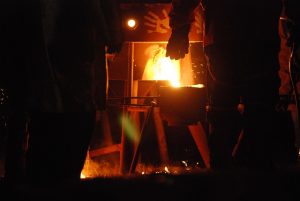
Forging and forming are two common types of metalworking processes. They both involve the manipulation of metal to achieve a different size and/or shape. From iron and steel to aluminum, bronze and more, countless metals and alloys support these two metalworking processes. Forging and forming aren’t the same, however. They each use a different method to manipulate metal. To learn more about the nuances between forging and forming in metalworking, keep reading.
What Is Forging?
Forging is a metalworking process that involves the use of pressurized blows to deform and, therefore, manipulate the shape of a metal workpiece. According to Wikipedia, it’s one of the oldest metalworking processes, with origins dating back to the 1100s when blacksmiths would use power hammers to shape metal workpieces. In the years since, new forging techniques have emerged. Regardless, all forging operations involve the use of pressurized and forceful blows to deform and shape a metal workpieces.
Although there are several types of forging operations, most fall under one of the three following categories:
- Drawn-Out Forging: Used to increase the length of a metal workpiece.
- Upset Forging: Used to crease the length of a metal workpiece.
- Squeezed-Compression Forging: Used to create multi-directional flow.
What Is Forming?
Forming, on the other hand, is a metalworking process that involves the use of mechanical deformation to deform a metal workpiece. By definition, the term “forming” refers to any metalworking operation in which a metal workpiece is deformed by mechanical means. With forming, the metal workpiece is deformed, meaning no material is added to the workpiece, and no material is removed from the workpiece. Therefore, forming doesn’t change the mass of metal workpieces; it only changes their shape.
There are compressive, as well as tensile, forming operations in metalworking. The former involves the use of compressive loading to deform metal workpieces, whereas the latter involves the use of tensile stress to deform metal workpieces. Rolling and extrusion, for example, are considered compressive forming because they use compressing loading. In comparison, stretching and recessing are considered tensile forming because they expose metal workpieces to tensile stress.
In Conclusion
Both forging and forming are designed to manipulate the size and/or shape of metal workpieces. The difference between them is that forging involves the use of pressurized blows to deform metal workpieces, while forming involves the use of mechanical deformation.
